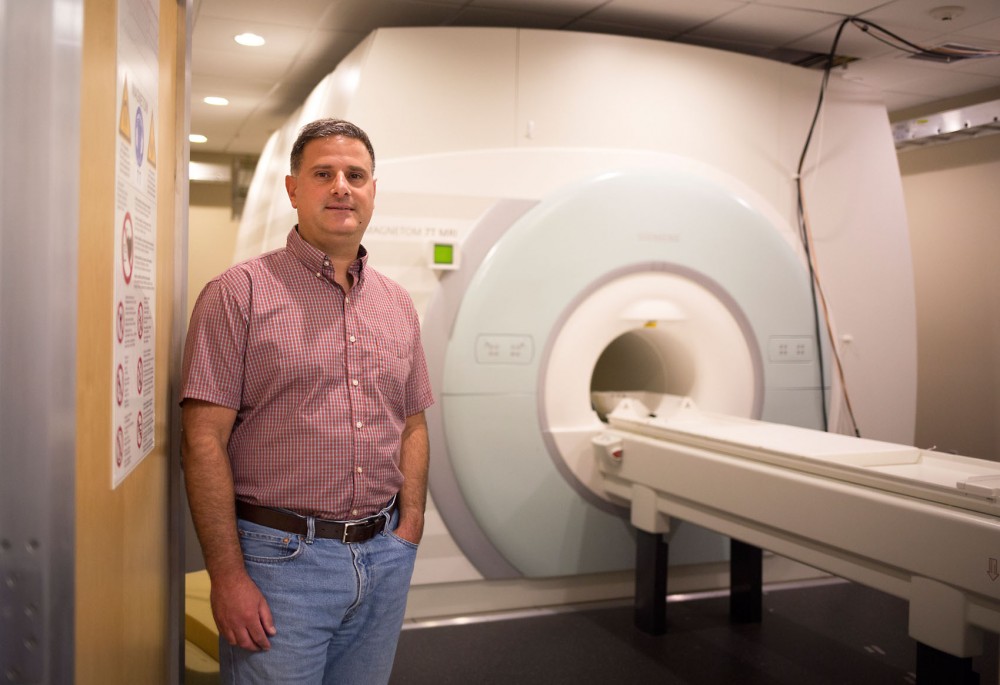When University of Minnesota neurosurgeon Dr. Michael Park explains to his patients how deep brain stimulation surgery works, he compares the process to finding a house with satellite images.
He tells his patients that the procedure is similar to locating a city, pinpointing the affected neighborhood, finding the target house and dropping a package — in this case, a DBS device, a probe made of four coiled wires — into the living room.
Deep brain stimulation surgery is used to relieve patients suffering from movement disorders with symptoms like intense and immobilizing shaking. Primarily used to treat movement disorders like Parkinson’s disease, essential tremor and dystonia, doctors offer the procedure when medication to fight these diseases stops working.
Now, the University of Minnesota Medical Center’s team of neurologists, surgeons, researchers and imaging specialists are researching new applications for the device and ways to spread knowledge about its potential positive effects.
The three hour surgery requires extensive planning that uses a large number of DBS specialists. Doctors decide if a patient qualifies for the procedure if their medication isn’t successful in reducing symptoms and if the disease isn’t far progressed, after which the candidate is sent for imaging.
At the University, Noam Harel, a researcher at the Center for Magnetic Resonance Research, uses a 7 Tesla MRI machine — a precise imaging device — to look at the of the portion of the brain that will be targeted during the surgery.
“You can generate better images, so we can actually see the targets that doctors … are aiming to put the DBS lead in,” Harel said. “Just think of a camera with much more pixels.”
Harel uses the MRI images to create a three-dimensional anatomical model of the patient’s brain for doctors to reference during surgery.
But before doctors can jump into surgery, they measure electrical currents in different parts of the brain. The step allows them to later accurately place the DBS lead, which will send electrodes to a specific spot in the brain to attack patients’ symptoms, University neurology chair Dr. Jerrold Vitek said.
“You go through different structures in the brain. It’s almost like going through different countries. Each area speaks a different language, so the pattern of activity of the cells
in each location can be quite different,” Vitek said. “When the pattern changes, we know we’re going into a different area.”
Reaching the target area of the brain requires the patient to be awake during surgery so doctors can monitor the brain at full activity and watch how moving the lead relieves patients’ symptoms, he said.
One of Park’s patients with essential tremor — a nervous system disorder that causes shaking — needed DBS surgery on both sides of his brain, but due to medical complications, the surgery had to be stopped after only one side was treated. A day after the surgery, Park’s patient went home and was already asking for treatment on the other half of his brain.
“The most common thing that patients say after the surgery is that they don’t know why they didn’t do it any sooner,” Park said.
In recent years, DBS research has started extending past movement disorders, said neurology assistant professor Ken Baker.
While the new projects aren’t receiving funding yet, he said researchers hope to use DBS for treating conditions like drug addiction and obsessive-compulsive disorder in the future.
Biomedical engineering researchers in are also working on creating new devices to reduce side effects of the surgery by better controlling the electrical current sent from the lead to the brain, Baker said.
Still, many don’t know about the surgery, Vitek said, partly because they work in hospitals that don’t supply the necessary equipment for the procedure. Only 20 percent of candidates in the United States opt for the procedure and 5 percent in the world, he said.
“A lot of places don’t have the equipment or the skillset to do this, but we need to get the word out to people,” Vitek said.
The University’s DBS team thinks education about the procedure could help more patients find normality in their lives and is working to spread the word as part of a MNDrive grant, he said.
“Just think if you couldn’t put on your makeup or brush your teeth or drink from a coffee cup,” Vitek said. “Just think what being able to do that would mean to you.”

















